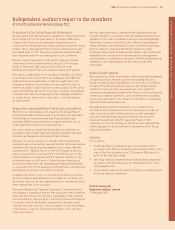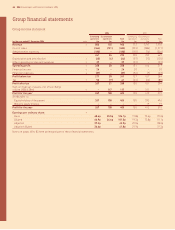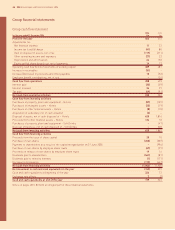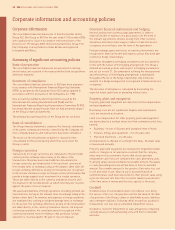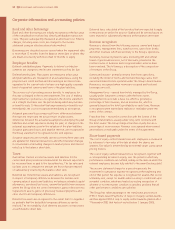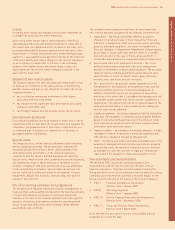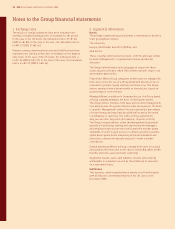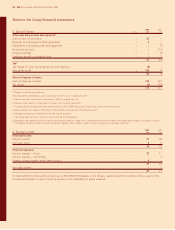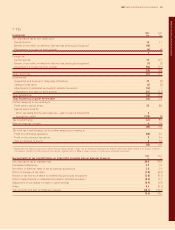Holiday Inn 2006 Annual Report Download - page 53
Download and view the complete annual report
Please find page 53 of the 2006 Holiday Inn annual report below. You can navigate through the pages in the report by either clicking on the pages listed below, or by using the keyword search tool below to find specific information within the annual report.
Corporate information and accounting policies
Leases
Operating lease rentals are charged to the income statement on
a straight line basis over the term of the lease.
Assets held under finance leases, which transfer to the Group
substantially all the risks and benefits incidental to ownership of
the leased item, are capitalised at the inception of the lease, with
a corresponding liability being recognised for the fair value of the
leased asset or, if lower, the present value of the minimum lease
payments. Lease payments are apportioned between the reduction
of the lease liability and finance charges in the income statement
so as to achieve a constant rate of interest on the remaining
balance of the liability. Assets held under finance leases are
depreciated over the shorter of the estimated useful life of the
asset and the lease term.
Disposal of non-current assets
The Group recognises the sales proceeds and related gain or loss
on disposal on completion of the sales process. In determining
whether revenue and gain or loss should be recorded, the Group
considers whether it:
• has a continuing managerial involvement to the degree
associated with asset ownership;
• has transferred the significant risks and rewards associated
with asset ownership; and
• can reliably measure and will actually receive the proceeds.
Discontinued operations
Discontinued operations are those relating to hotels sold or those
classified as held for sale when the results relate to a separate line
of business, geographical area of operations, or where there is a
co-ordinated plan to dispose of a separate line of business or
geographical area of operations.
Special items
The Group discloses certain financial information both including
and excluding special items. The presentation of information
excluding special items allows a better understanding of the
underlying trading performance of the Group and provides
consistency with the Group’s internal management reporting.
Special items, which include other operating income and expenses,
are identified by virtue of either their size or incidence so as to
facilitate comparison with prior periods and to assess underlying
trends in financial performance. Special items can include, but
are not restricted to, gains and losses on the disposal of assets,
impairment charges and reversals, restructuring costs and the
release of tax provisions.
Use of accounting estimates and judgements
The preparation of financial statements requires management to
make estimates and assumptions that affect the reported amounts
of assets and liabilities, disclosure of contingent assets and
liabilities at the date of the financial statements and the reported
amounts of revenues and expenses during the reporting period.
Actual results may differ from these estimates under different
assumptions and conditions.
The estimates and assumptions that have the most significant
effect on the amounts recognised in the financial statements are:
• Impairment – the Group determines whether goodwill is
impaired on an annual basis or more frequently if there are
indicators of impairment. Other non-current assets, including
property, plant and equipment, are tested for impairment if
there are indicators of impairment. Impairment testing requires
an estimate of future cash flows and the choice of a suitable
discount rate and, in the case of hotels, an assessment of
recoverable amount based on comparable market transactions.
• Pension and other post-employment benefits – the cost of
defined benefit pension plans and other post-employment
benefits is determined using actuarial valuations. The actuarial
valuation involves making assumptions about discount rates,
expected rates of return on assets, future salary increases,
mortality rates and future pension increases.
• Tax – provisions for tax accruals require judgements on the
interpretation of tax legislation, developments in tax case law
and the potential outcomes of tax audits and appeals. In
addition, deferred tax assets are recognised for unused tax
attributes to the extent that it is probable that taxable profit will
be available against which they can be utilised. Judgement is
required as to the amount that can be recognised based on the
likely amount and timing of future taxable profits, taking into
account expected tax planning.
• Loyalty programme – the future redemption liability included in
trade and other payables is estimated using actuarial methods
based on statistical formulae that project the timing of future
point redemptions based on historical levels to give eventual
redemption rates and points values.
• Trade receivables – an allowance for doubtful amounts of trade
receivables is made on the basis of historical experience and
other factors considered relevant by management.
• Other – the Group also makes estimates and judgements in the
valuation of management and franchise agreements acquired
on asset disposals, the valuation of financial assets classified
as available-for-sale, the outcome of legal proceedings and
claims and in the valuation of share-based payment costs.
New standards and interpretations
The IASB and IFRIC issued the following standards and
interpretations with an effective date after the date of these
financial statements. They have not been adopted early by the
Group and the Directors do not anticipate that the adoption of these
standards and interpretations will have a material impact on the
Group’s reported income or net assets in the period of adoption.
• IFRS 7 Financial Instruments: Disclosures
Effective from 1 January 2007
• IFRS 8 Operating Segments
Effective from 1 January 2009
• IFRIC 10 Interim Financial Reporting and Impairment
Effective from 1 November 2006
• IFRIC 11 Group and Treasury Share Transactions
Effective from 1 March 2007
Note: the effective dates are in respect of accounting periods
beginning on or after the date.
IHG Group financial statements and accounting policies 51




